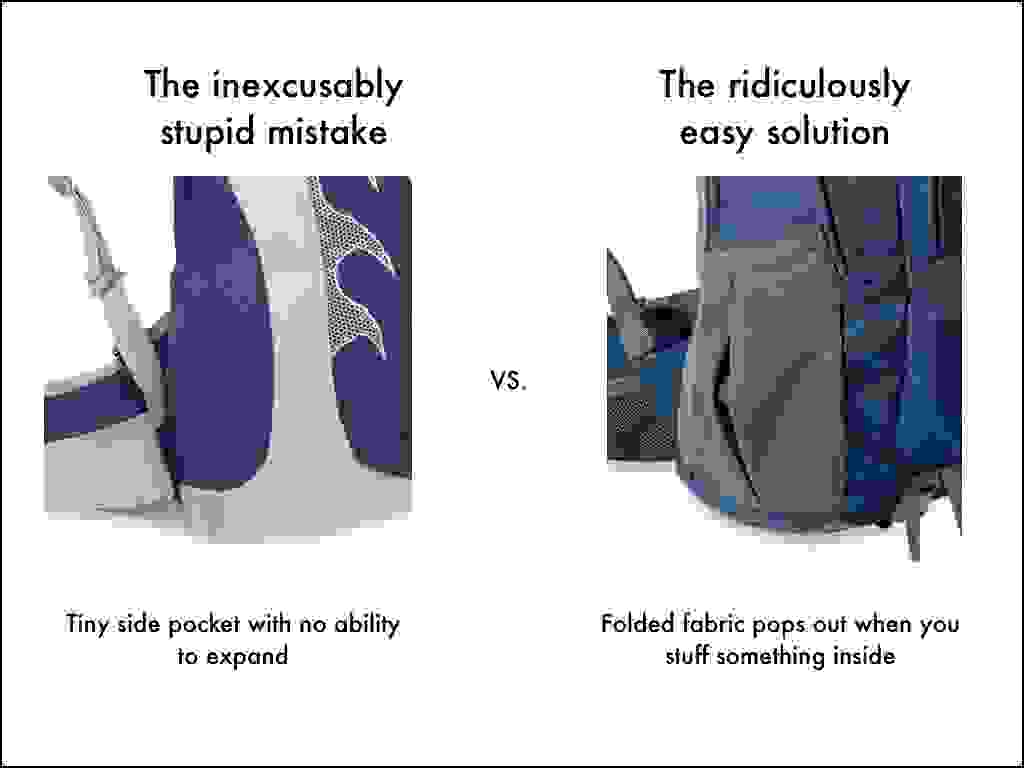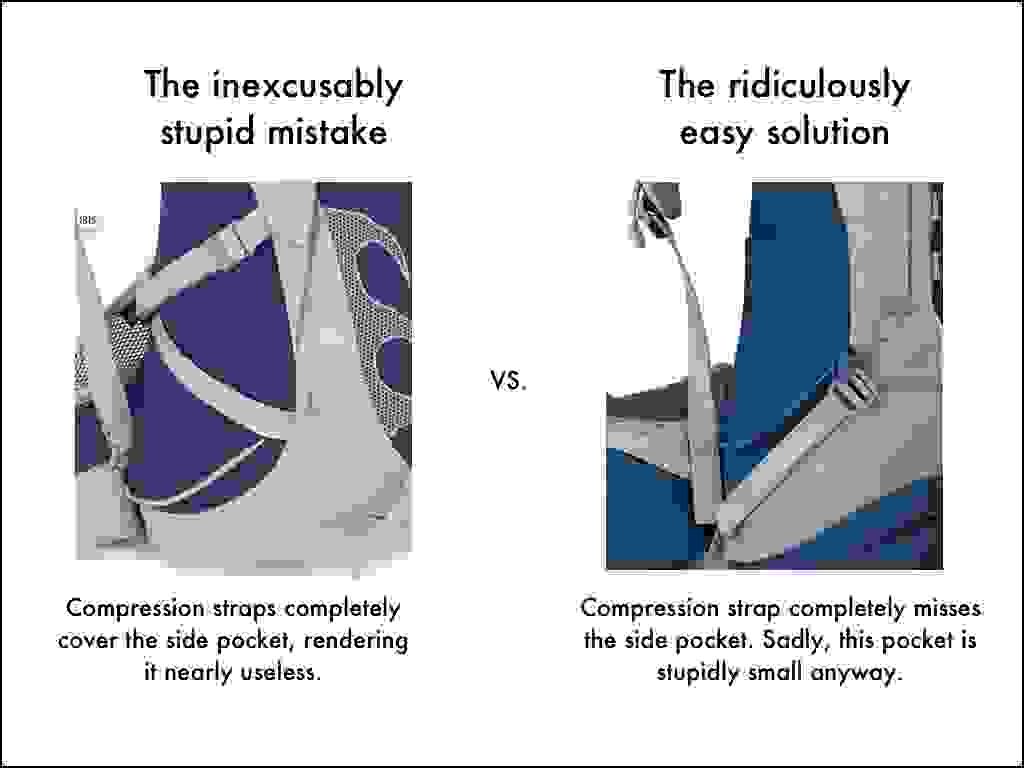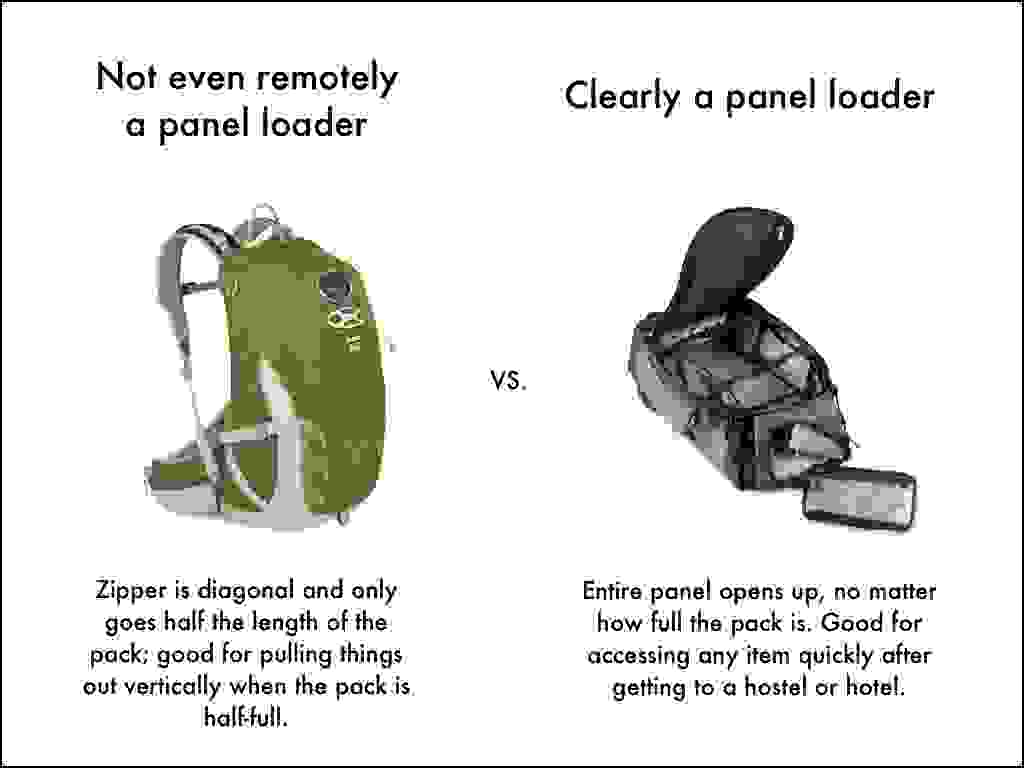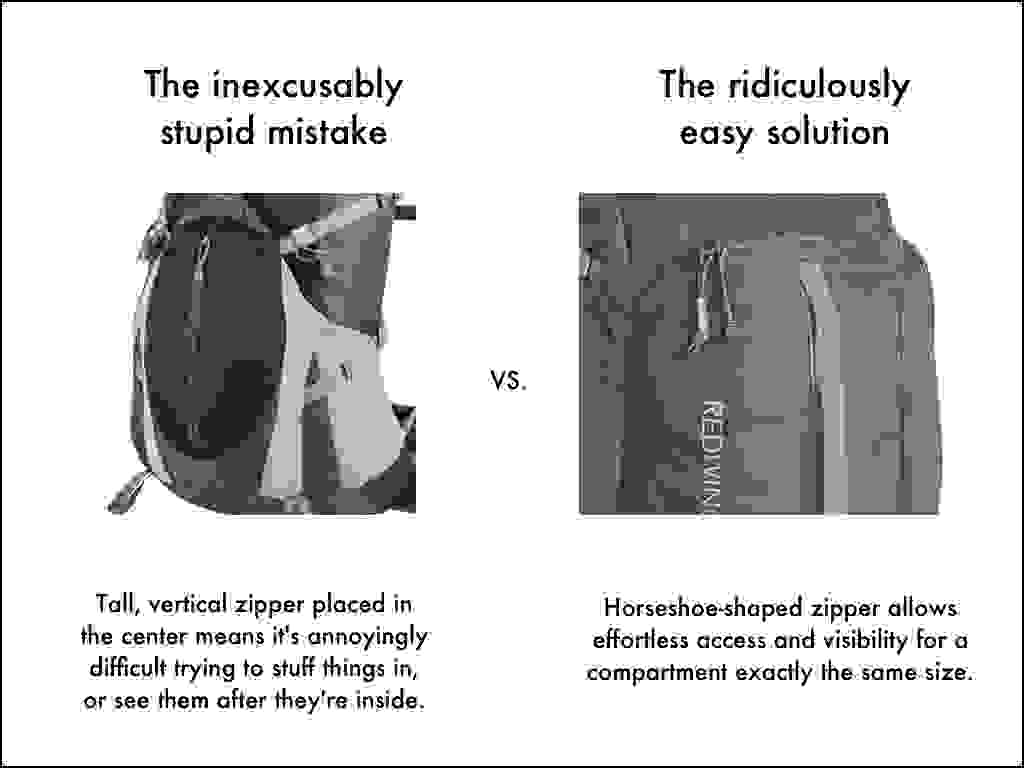As many of you may know, I am an endless complaining machine that cannot be satisfied even by the most magnificent of creations anywhere to be found. This debilitating curse manifests itself most thoroughly when it comes to high-tech travel gear, much of which is cartoonishly ruined by moronic designers who seem to have absolutely no idea that even the smallest of modifications could vastly improve their creations by several orders of magnitude.
I have no earthly idea how they’re able to screw things up so frequently, and many a strongly-worded-letter has departed from my desk, only to be cursorily answered or summarily ignored by the willfully foolish recipients whose job descriptions apparently do not include “making things not suck.”
So I’ll just complain here instead.

Backpack manufacturers make a massive variety of packs, churning out the designs every single year, with a billion different sizes, colors, configurations, and everything else. You’d think they’d provide enough variety to satiate the needs of even the most discerning of pack enthusiasts. But nay. Somehow they still manage to screw things up all over the place.
Now I’ll readily admit that in many cases, my subjective needs are not universally ideal; travel-specific packs require a somewhat different set of features compared to hiking packs, and the comparative rarity of travel packs means I quite often have to make do with a hiking pack, which is a bit like giving dog food to a crocodile. He’ll eat it, sure, but it’s still dumb.
But they’re not getting away so easily. Nay! I am here to complain, and complain I shall.
The following problems consist exclusively of design flaws that are not subjectively unsuitable for my purposes, but are just objectively stupid. They’re wrong. Plain and simple. And people need to stop doing them.
Let’s begin.
Backpack design flaws that need to stop immediately
1. Stupidly tiny “water bottle” pockets
I have absolutely no idea how this trend started. I think it has something to do with the popularity of hydration bladders, and backpack manufacturers figured that’s all they had to worry about. If everybody just has a hydration bladder, they won’t be storing a water bottle in a side pocket.
But not everybody has a hydration bladder. In fact I’d be willing to bet that more people have water bottles than hydration bladders, and they need a place to put them goddammit. Where the hell can they go besides the damn side pocket?!?! Not in the main compartment of the pack, surely. Not only is it a stupid hassle to take it out whenever you need a sip of water, but if there’s a leak of any kind, all of a sudden your day is ruined.
But I see backpacks all over the place…seemingly the majority of them…that have extraordinarily small side pockets with no ability to expand whatsoever. Which means they’ll be flat against the wall of the pack itself with a round water bottle trying to find its way inside! You’re literally stuck trying to fit a round object into a flat compartment. Do they even bother trying to fit any of those bottles that are sold in the same stores into the side pockets before shipping the product out the door?!?!
But they even issue promotional photos displaying a water bottle fitting into the pocket. Quite often the pack itself is only partially filled, meaning the water bottle dug into the empty space of the main compartment, meaning if the bag were full, you’d be out of luck.
And it’s not like they can’t handle solving this problem. It’s actually stupidly easy. All they have to do is:
- Use stretchy fabric
- Fold the fabric
In fact you only really need to do one or the other. In either case, the fabric will lay flat when the pocket is empty, and pop open when you stuff a water bottle inside. It’s literally that simple. And even if you don’t need to fit a water bottle in there, it’s still objectively superior anyway.
Behold:

I will never stop complaining about this, because it’s the most annoying thing in the world to me. I shouldn’t have to figure water bottle location into pack purchase decision making. They should just all be good.
2. Compression straps that cover the side pockets
So it’s one thing to make a side pocket so stupidly small that you can’t use it. But it’s another thing entirely to have a perfectly good pocket and lash something right over the top.
They’re called “compression” straps, and you have to pull them tightly to compress the pack. And you know what happens when you pull a strap tightly over a pocket? You can’t use the pocket anymore. You literally have to decide whether you’re going to use the pocket, or the strap, but not both. Or at least, not very well. The strap won’t be doing much in the way of compression if it’s loose enough to access the pocket itself, and thus is pointless.
The worst offense is when not one but two straps go right over the side pocket. On packs so small that they don’t need the double strap anyway!
In some cases, these straps can actually be routed behind the side pocket, so they won’t get in the way of things. But the fact that certain companies allow this option only on some of their packs is incredibly annoying. It’s also not even the best way to solve the problem.
Once again, a variety of solutions exist. Here’s the easiest one:

You can cut them off, but why don’t they just not do stupid things to begin with?!?!
3. Filthy dirty lie “panel” loading
This is mainly a vocabulary problem. Allow me to elaborate:
Backpacks come in a few varieties: Top loaders, which consist of giant cylindrical main compartments with a lid on the top; and panel loaders, which have a large, horseshoe-shaped zipper which allows the entire pack to be opened up like a suitcase.
Except when they fail to make the zipper go all the way to the bottom of the pack and you can only open it halfway. Plus, they’ll put the zipper in the middle of the pack, rather than at the edge, making it even more difficult to open completely.
Which means it’s not a panel goddammit. Check the damn dictionary!
Now I’ll admit that in some cases the half-panel loaders (that’s what I’m calling them) have their merits. School, for example. When you want to flip through a few books, all of which are balanced vertically, you’d want to open the pack from the top and flip through the options and take your pick. This works better than a full-length panel loader, which you’d sort of need to place flat on the ground to see what’s inside, and even then, you’d probably only be able to see one book at a time, unless you arranged them differently than anyone in the world ever has.
But it’s a terrible way to organize anything else. If you’ve ever had a sock at the bottom of the pack, you need to unload the whole damn thing to find it. And this is the weakness of half-panel loaders. They are by far the most difficult type to fill to capacity. And once you’ve packed them nearly full, it’s incredibly difficult to access anything at all.
It’s not to say they’re bad, but they’re horrible in certain cases. Travel, for example. And regardless, they certainly shouldn’t be called “panel” loaders.

Again, half-panel loaders have their merits, but when I say I want a panel loader, I mean a real one.
And there’s a very clever hybrid solution found in the Kelty Redwing, which combines top loading with panel loading into a single zipper. Unfortunately, it was one of the most horrifically uncomfortable things I’ve ever experienced.
4. “Bridge” shoulder strap

I have no idea who thought up this incredibly stupid idea. I bet it went something like this:
“Hey guys! Let’s change something that’s been working perfectly for decades!”
“Um, why?”
“Because fuck you, that’s why!”
I’m referring to the so-called “haul loop” found at the top of the pack. You can use it to pick up the bag, hang it on something, or whatever. And a few companies have started making bags where the haul loop is integrated into the shoulder straps, forming a bridge between them.
This is a terrible idea. I mean really awful. It means you cannot adjust the pack to fit high up on your back. You are required to carry it lower on your back than you otherwise could, meaning if you like wearing it up high, you’re stuck with something digging into the back of your neck all day.
I’m pretty sure the designers consisted of incredibly large people who wear their packs low and never bothered checking with anyone else.
Oh, and the haul loop is smaller and thus harder to grab, and it’s vertically positioned rather than horizontally, so it’ll dig into your fingers more. Hooray!

Seriously, how did no one say anything?
5. Centrally-placed vertical zipper
Okay, I know this one is kind of a reach, because it’s somewhat obscure. But it’s also dumb.
I’ve only seen this in a few places, and I think it’s supposed to be for maps, which are (usually) vertical pamphlets that can be slipped inside flat pockets with tall zippers. But tall, centrally-located vertical zippers are just incredibly stupid.
Firstly, it’s hard to put small things in there. It’s practically impossible seeing inside while trying to find them, and they might even fall out. And secondly, it’s also difficult putting large things in there. It seems like a decent place for a rain jacket, but the process consists of stuffing the jacket into the left half of the compartment, and then stuffing the rest into the right half. You literally cannot access the entire pocket all at once, because it’s just this tiny slit that’s somehow supposed to provide access to this massive pocket.
I had this sort of zipper on an old pack of mine, and I literally did not use the pocket. Ever. It just sat uselessly. It’s so difficult trying to take things in and out that I just didn’t bother anymore.

I really don’t get this one either. If you’re supposed to fit tall, flat papers into there, it would still work better to put the zipper literally anywhere else. Horizontally across the top, or vertically along the side. But, best of all, upside-down letter U. Done and done.
Backpack design error objective vs. subjective
Now I’ll readily admit that my particular needs may not be the same as those of someone else. But in the cases listed above, with the exception of the panel-loader vocabulary problem, the design choices are just objectively wrong. And, annoyingly, they are incredibly frequent. I really have no idea why they continue to exist.
I wonder if it’s simply that most people are more or less fine with a pack as long as it’s good, and they’ll live with the limitations as long as it holds up to serious use. I’d feel that way as well, but when I see design flaws, especially incredibly dumb ones, it just ruins my whole day.
A few more:
- Backpack manufacturers have apparently not realized that the load lifter straps (the small strap on top of the shoulder strap, that pulls the pack closer to your body) can be routed quite conveniently into hydration bladder port straps. Pretty much ever pack has a tiny strap, on the shoulder strap, where a hydration bladder hose is held in place. It’s also a great place to stick the load lifter straps so they don’t flail around annoyingly. The reason I think pack manufacturers haven’t realized this is that sometimes they’ll only put a strap on one side, instead of both.
- You know those hip stabilizer straps? Basically, it’s the small strap, on top of the hip strap, that pulls the pack closer to your body. It also forms a dangly thing that, if you have dual hip belt pockets with a slot where the dangly strap can go, can be kept out of the way. Once again, I don’t think pack manufacturers have quite realized this, because many of them give you only one hip belt pocket and the strap on the other side dangles annoyingly.
- When the base is rounded instead of flat, the pack falls over whenever you set it down. It’s incredibly annoying.
- If you have a top loader pack whose lid pocket attaches to a strap whose only connection point to the pack itself is at the very bottom of the pack, every time you unclip the buckle to open the pack, the strap will fall all the way to the ground. There could be something to prevent this, and it would be incredibly easy. I used dental floss. I’m sure they could do something a little more clever.
And you’ll notice that in many of the pictures shown above, the “bad” pack was an Osprey pack. And there’s a reason for that. Osprey make a million different packs, and plenty of people are happy with plenty of them, but…if I want to find a pack that’ll annoy the hell out of me, I know exactly where to go. Osprey is the absolute biggest culprit of tiny side pockets, and straps covering the side pocket anyway. Among other things.
I intend to continue complaining about these problems until I become such a thorn in the side of these companies that they are forced to acquiesce to my demands. Wish me luck!




As a Pack Designer working on a line of Travel Packs, your words are noted and I’ll do my best to make you happy man. Keep up the good work and know that some of us (pack designers) are listening to what people have to say. Unfortunately, we don’t always get to make the final decisions in pack design…weird as that is. I love reading your blog!
What about happy WOMEN???? We are hikers too.
Given the phrase, I think the mistake was simply dropping the word “a”, rather than – as you must have thought – using “man” instead of “men”.
I don’t think anyone these days is careless of women’s needs – I see plenty gear available in pink in the stores. ;-)
I agree that there is too much gender hyper-sensitivity in the world today, but I love brown/tan, green, camo, and non-baby blues…still not much color selection for chicks that isn’t also suitable for Easter eggs.
Oh Lord, who cares? Stop worrying about politically correct BS and focus on the article.
Hi Frankie. It’s not PC bullshit. Go try to find a technical women’s pack. “They’re mostly unisex” you say? WRONG. Almost all “unisex” packs are anatomically for men.
I hereby challenge all male backpack/hiking enthusiasts! Try this one: from hence forth, you may not buy or own any backpack that isn’t also sold as a women specific version. As “women specific” I’ll include not only packs sold/branded as such, but any pack that is also available or adjustable for short torso lengths (down to let’s say 14”), or where the manufacturer makes a women specific pack with the same features and overall look (like Mammuts Lithium and Lithia packs).
An instant disqualification of the male version occurs if the female version has a ridiculous reduction in volume. Like the men’s is 20L and the women’s is 19L, that’s fine, but if the women’s is 15L, nope, that’s not serving the same purpose.
And no, you cannot have any of a manufacturers packs just because they have a few female specific packs- but that have different features to the one you want that’s only available for men/longer torso.
I can almost guarantee, if you apply these rules, you’d have to throw out most, if not ALL of your technical packs. And YES, torso length matters a whole lot to fit. There’s also aspects like the height of the sternum strap (on many “unisex” packs this is frequently so low that women can’t adjust the sternum strap to be above the breasts, which results in the situation where standing up straight actually transfers weight ONTO your boobs, and pulls the shoulder straps into the sides of the boobs, and I know it sounds funny but it’s a real comfort killer) and the shape of the shoulder straps (often too wide and straight), and the angle of the hip belt, etc. But I’m focusing on torso length here because it’s measurable.
What do you do if the torso length isn’t listed? Well, if it’s a small pack where the pack does not protrude over the height the shoulder straps attach at, you can use the packs height.
Or, you can email the manufacturer and have many many convos that go like this:
You: hi there. Is the [productname] suitable for women? What is the torso length range it fits?
Manufacturer:
Thanks for your interest, let me check with our advisors.
[a week later]
manufacturer:
Yes! The [productname] is suitable for women. It fits a torso length range of [literally the average torso length range of men].
You: oh.. most women would have to be significantly above average height to have that torso length.
You see, not only are women usually a bit shorter than men to begin with, but proportionally we are not the same- we have less torso and more leg, basically. So you can see how the average torso length range for men is completely out of reach for most women, unless they are very very tall- they’d literally need to be taller than the men the pack is fit for. This insta-disqualifies almost all “unisex” packs, unless they are adjustable, or sold in different size options, since almost all of the so called unisex packs fit male torso lengths.
Let me know if you find any.
PS: yes I get that the original “make you a happy man” comment was all casual and lighthearted. But if you were in my can’t-find-a-pack-that-fits shoes, it touches a raw nerve damnit.
This was an insightful read. I’m shopping daypacks to replace my Osprey Axis (which has no mesh side pockets for a canteen) with something that’s a little larger and has side pockets.
Osprey Axis:
http://www.campmor.com/osprey-axis-daypack.shtml?source=CI&ci_sku=65683ORA&ci_gpa=pla&ci_kw=
Osprey Stratos 26 (the pack I’m considering):
http://www.ospreypacks.com/en/product/mens/stratos_26_1
Do you have any opinions on this pack? Besides breaking rule #2, it seems like a pretty solid pack. Do you have any recommendation on a better pack which has comparable features/volume?
Thanks!
-Bob
When I tried this on in the store, it just felt weird, even in the right size. I may have a weird spine, which is why I have difficulties finding good packs, but if you’re looking for a great backpack with that trampoline-style back panel (that’s what the Stratos has), my immediate first recommendation is always the Gregory Z series. I find the design a whole lot more comfortable, and I find the layout more convenient.
They don’t have a design directly comparable to the Stratos 26, though; there’s the Z25, and the Z30, which are similarly sized, but they’re not top-loaders (don’t know if you care or not, though); the Z35 and larger ones are top-loaders, and they also have U-shaped zippers to open up kind of like a suitcase. Straps don’t interfere with anything, the side pockets are big, they have included rain covers, and they feel great. I like that series of packs quite a bit.
If you don’t need the trampoline back panel, their Miwok packs are pretty great too, and I’m also a fan of the Tom Bihn Synapse (reviewed here; no side pockets, but there’s a dedicated, centrally-placed water bottle pocket, if that’s what you want), and the Ivar line of packs, which have a neat organizational system that stacks things vertically, instead of letting them slump to the bottom.
Thanks! I didn’t realize the Z series went all the way down into the 20s of liters. I actually own a Z65 (2011’ish) and it’s been wonderful, although I did have to purchase a rain cover separately at the time.
I’m actually not so much needing a top-loader — what I’m really after is the convenient zippered pocket(s) on the hood of a top-loader. I find the zippered hood pocket to be superior to internal pockets in a panel loader, as digging into a panel loader twice (once for the main panel, then again for small zippered pockets within the panel compartment) is inconvenient to fish out sunscreen, keys, phone, etc.
I’ll check out the Z25. Incidentally, one of the other requirements of the new daypack needs to be that it’s accepted in size as my one ‘personal item’ for air travel (not the ‘carry-on’ but the smaller ‘personal item’ which I’ve been using the Osprey Axis for). Do you know if there’s generally an acceptable volume/size where the ‘personal item’ is no longer considered small enough and instead counts towards your ‘carry-on’?
Thanks again,
Bob
The “personal item” limitations are a lot messier than the carry-on limitations, but the basic idea is generally that the carry-on item has to fit in the overhead bin, and the personal item needs to fit under the seat in front of you. United actually has measurements (others sometimes don’t), listing them as 17x10x9 inches, which is maybe the size of a small school backpack. It looks like the dimensions on the Z25 might be a close call…but if you leave it just a little unpacked, it’s probably fine. Tell people you’ve stuck it under the seat a million times and they’ll probably be happy.
Being an owner of an Osprey pack, I do see some of the limitations that you discuss, and have one to add; the water bottle “pocket” things are elastic and have frequently squeezed my nalgene bottles out, especially when putting the pack on. This leads me to my next point. when you want to take the bottle out of the pouch, it is in the exact wrong spot. I can take the bottle out barely, but have to take the pack off to get the bottle back in, if the pouch were a few inches towards the back panel, or a few inches (or less) up or down on the pack it would be better. I love how comfortable Osprey packs are, and the bladder pouch is ingenious but the water bottle things are just annoying.
Some companies do an angled water bottle pocket; certain REI packs have this feature, where the water bottle goes in at a 45 degree angle or so, which makes it a lot easier to access while you’re wearing the pack. Not sure why this feature is so rare, though. I’ve seen an Osprey pack or two with this as well.
You have nailed it with this article, right now I am looking for a pack for a get home bag, my criteria is –
2x external bottle pouches of a decent size
Neutral colour (not black, not bright)
Reasonable price and weight
Not tactical looking
A front pocket with a normal horizontal zipper
Less than 20L capacity
I have spent hours and hours looking and have found nothing, the infamous Kanken comes close except the stupid water bottle holders, what were they thinking?
On the other end of the spectrum is the Pygmy Falcon, it falls down with molle straps and is pretty damn heavy for its size, a bit pricy but I could live with the price if the rest was ok.
Most importantly every single one of the thousands of hiking packs I have looked at don’t have a front pocket or usable water bottle pouches, I have done a lot of hiking and day hunting so my question is “who are they designing these packs for?”
They obviously assume that everyone uses a hydration bladder, but as someone who lives where water from streams is drinkable it is just stupid, it is easier, cheaper and lighter to just use the ultralight plastic bottles that store bought water comes in most of them are between 750ml and 1 litre, bottle pouches should be able to fit those at least.
The worst thing is none of the pack retailers sell add on water bottle pouches, I mean how hard could it possibly be to sell a cheap sew on pouch like the one on the side of this duty bag –
http://images.knifecenter.com/thumb/1500×1500/knifecenter/hwi/images/DB100.jpg
It’s really amazing just how many there are, yet somehow people have the same complaints. Oh well. Good ones include Tom Bihn and Ivar, since they do something different from all the others, and I think North Face has some good ones as well, which are easy to find all over. If you’re looking for hiking packs, Gregory is what I always recommend. Their Z series and Miwok series are really great.
Take a look at the REI Trail 20
Good post! You rant about the same petty mistakes i do in this matter too!
One daysack i have found to meet the features we want is the Mountain warehouse Ventura 40 day sack. It has 2 expandable side bottle pockets, 2 expandable zipped side pockets and 2 compression straps each side. As well as hip pockets and 2 lid pockets. Hydration sleeve inside too. Lower and upper loading and a front pouch.
Its rare to find a pack that has all the features a fan wants!
I have to concur with your rants as I too am prone to rant and email and write in regarding issues with some success and some not so. The issue here is the fact, which occurs all too frequently in that design engineers seem to be devoid as too are the companies they work for, of ‘brace yourself for wisdom’ asking the feckn client in this case the end-user what the requirements are. Design a bag with customer input novel idea we are afterall the stakeholder that matters since we buy them…e.g. I want a bag to hold a KK 64oz water bottle I just do I drink a lot of water no camel packs for me thank you. No sloshing about…I want a side pocket that is compression or some sort of draw string so i can hold a water bottle that is about 10×5 inches…must require Hawking, Cox and Turring from his grave to figure this out because clearly this type of canteen does not exist nor do any of us actually use them oh they do exist I have one so i must be imagining the need I have…I am in two minds to set up a survey monkey poll and then hit every blog site to encourage viewers to input requirements then design a prototype Dragons Den here I come…the belt pockets are also something that basically functionless you can hardly get your fingers in…I will stop there keep up the good work.
This is beautiful thank you so much I thought I was a lunatic for having such strong issues against certain backpacks based of their poor funcunality
LOL I was exactly thinking about the same problem about the tiny water bottle holders. :S
Luckily there is a water bottle nearby the sales shelves so that I could try if a normal-sized water bottle can fit in the water bottle holder of the bags and figured it out that the water bottle holders do not work. Ended up not buying any of the bags and sought for better bags.
That’s what I did. I filled up the pack, and then tried to stick a water bottle inside, and failed. And it as a Camelbak, which is one of the semi-skinny ones. The Nalgene fans are even more out of luck.
I have the hiking backpack of your dreams then. Water bottle fits in a zipped side compartment, you can affix the hydration tube to it also. The compression straps only run along the front. Hydration tube travels through the strap so it doesn’t interfier with the strap adjustments, all loose straps either have a cubby or velcro wraps to put them away. It also has pocket for hydration bladder if you have one. Seperate media pocket with headphone port. Other side pocket fits ski goggles and zips or a large sunglasses case. Its a top loader(but since its a hiking backpack is okay) and its a medium size perfect for 10-20 mile hikes.
I really like Gregory’s Z series of packs (known as the J series for women). They do all of this quite nicely. What’s yours, though?
A photo and a name for your super-pack would be nice.
Just wanted to toss out a suggestion. My closet looks like a graveyard for backpacks from little 10l day packs to 80l “why did I bring all this crap” expedition packs. I almost exclusively carry my GR1 or GR2. Their obvious downside is their weight (GR1 is 26L at ~4ish lbs) but their super tough and the material is so thick it keeps the content inside dry even when submerged (thick river crossing gone fun).
The company is run by veterans so the packs do have “that” look, but its subtle, and it has the added benefit of molle on the sides to attach your water bottle holder. They aren’t cheap but I wouldn’t travel with anything else at this point.
I like the design quite a bit, and the only problems I could see were the weight, and the lack of a hip belt, although they’ve now added an optional hip belt, so that takes care of it somewhat. Still, they’re heavy, so I think they’re mostly for big, muscular people, which makes sense from the military design. They’re for people who can go for a marathon carrying half their body weight on their back without a hip belt, but not so much for tiny weaklings like me. But in terms of functionally and durability (or for people carrying smaller loads), they look great.
They actually do offer a belt http://www.goruck.com/heavy-duty-padded-stabilizer-belt/p/GEAR-000496. While its not some huge padded support belt, its looks on par with the belts on smaller osprey packs. I haven’t used it, mostly because thanks to some weird voodoo I’ve never needed it.
I’ve always joked that I have the lower body of a man and the upper body of a kid. At 6’3″ 180 I’m all leg muscle and have no meat on my shoulders. I still don’t notice my GR1 with 25lbs in it. The shoulder straps are so thick and padded they just form around my body. Same with the back plate on the pack. Maybe its magic but it feels like the pack just molds to you and holds on.
Although I totally noticed the extra weight at first. There’s no way around that….. but in the end… its only 4lbs. After a few weeks I hardly noticed anymore.
Yeah, that’s the belt I meant. It’s quite useful. I need the belt if I’m carrying more than 10 pounds of gear. It’s also helpful just to stand up straight, since you don’t have to hunch forward to balance yourself as much. It might be that some packs out there are better, but I’ve never been able to find a pack that I could wear without a hip belt if it’s more than 10 pounds, but I’m pretty tiny, so that’s probably why.